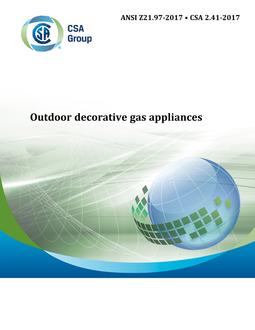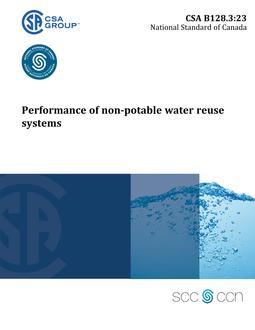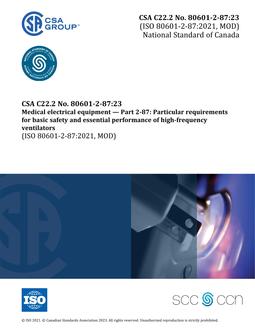
CSA ANSI Z21.97-2017/2.41-2017
Click here to purchase
Scope
1.1 This Standard applies to newly produced decorative gas appliances for outdoor installation (see Clause 3, Definitions), constructed entirely of new, unused parts and materials; hereinafter referred to as “appliance.” Appliances submitted for examination under this Standard are classified as one of the following: portable, stationary, or built-in.
1.2 Appliances may be for:
a) connection to a fixed fuel piping system; or
b) connection to a self-contained propane gas supply system (see Clause 3, Definitions). Cylinder(s) for a self-contained system may be either remote to the appliance or integrally mounted on the appliance, are designed for vapor withdrawal only.
- Appliances with input ratings less than 60,000 Btu/hr (17 584 W) are designed to accommodate a vertically mounted integral cylinder with a maximum size of 20 lb (9.1 kg) of fuel.
- Appliances with input ratings greater than or equal to 60,000 Btu/hr (17 584 W) may be designed to accommodate a vertically mounted integral cylinder with a maximum size of 30 lb (13.6 kg) of fuel.
- Appliances with input ratings greater than or equal to 80,000 Btu/hr (23 446 W) may be designed for not more than two vertically mounted integral vapor withdrawal cylinders, each with a maximum size of 20 lb (9.1 kg) of fuel.
- Portable appliances intended for table top use are to have input ratings limited to not more than 15,000 Btu/hr (4 396 W), and are designed to accommodate a vertically mounted cylinder with a maximum size of 16.4 oz (465 g) of fuel.
- Portable appliances with input ratings not greater than or equal to 25,000 Btu/hr (7 327 W) may be designed for the use of not more than two cylinders, each with a maximum size of 16.4 oz (465 g) of fuel.
- Appliances designed for use with remote propane cylinders are limited to one cylinder of maximum 30 lb (13.6 kg) of fuel or two cylinders with maximum of 20 lb (9.1 kg) of fuel each.
1.3 This Standard applies to appliances operating at inlet gas pressures not to exceed 1/2 psi (3.5 kPa) for connection to a fixed fuel piping system and for use with:
a) natural gas; and
b) propane gas.
1.4 The construction of an appliance for use with the above-mentioned gases is described in Clause 4, Construction. The performance of an appliance for use with the above-mentioned gases is described in Clause 5, Performance.
1.5 This Standard also applies to appliances designed for connection to self-contained propane gas supply systems:
a) operating at regulated outlet pressures not to exceed 11 in wc (2.74 kPa); or
b) operating at regulated outlet pressures in excess of 11 in wc (2.74 kPa) but not greater than 5 psi (34.5kPa).
1.6 Built-in appliances may be for:
a) connection to a fixed fuel piping system; or
b) connection to a remote self-contained propane gas supply system (see Clause 3, Definitions), provided the appliance is supplied with remote mounting and retention means for the attachment of a single cylinder with a maximum size in accordance with Clause 1.2b)i) or Clause 1.2b)ii) and instructions for installing the mounting and retention means within the built-in enclosure.
1.7 Thermostatically controlled appliances are not within the scope of this Standard.
1.8 If a value for measurement as given in this Standard is followed by an equivalent value in other units, the first stated value is to be regarded as the specification.
1.9 References to “psi” in this Standard are to be considered gauge pressure unless otherwise specified.
1.10 Clause 7 contains provisions that are unique to the United States.
1.11 Clause 8 contains provisions that are unique to Canada.
1.12 Clause 2, Reference publications, contains a list of standards specifically referenced in this Standard, and sources from which these reference standards may be obtained.
1.13 In this Standard, “shall” is used to express a requirement, i.e., a provision that the user shall satisfy in order to comply with the standard; “should” is used to express a recommendation or that which is advised but not required; and “may” is used to express an option or that which is permissible within the limits of the standard. Notes accompanying clauses do not include requirements or alternative requirements; the purpose of a note accompanying a clause is to separate from the text explanatory or informative material. Notes to tables and figures are considered part of the table or figure and may be written as requirements. Annexes are designated normative (mandatory) or informative (non-mandatory) to define their application.
Product Details
- Edition:
- 3rd
- Published:
- 12/01/2017
- ISBN(s):
- 9781488307089
- Number of Pages:
- 133
- File Size:
- 1 file , 1.6 MB
- Product Code(s):
- 2425082, 2425082, 2425082


